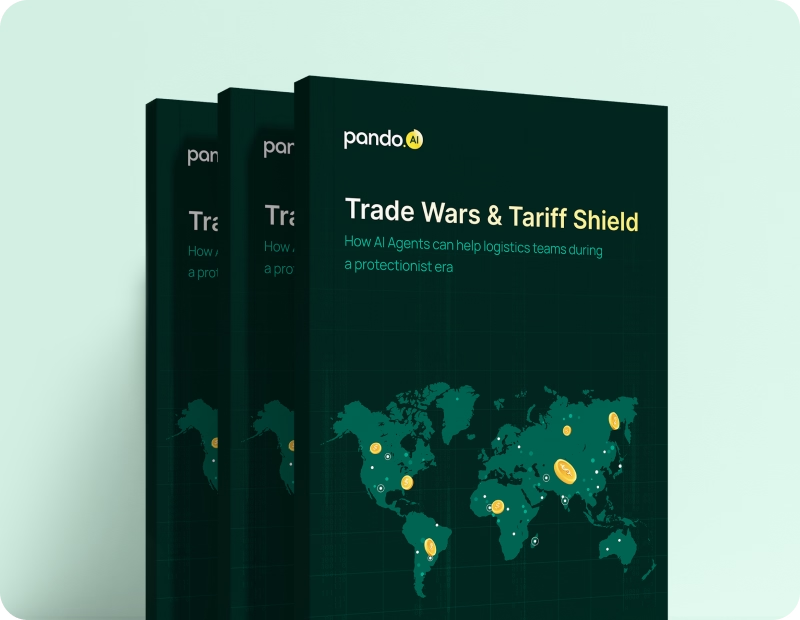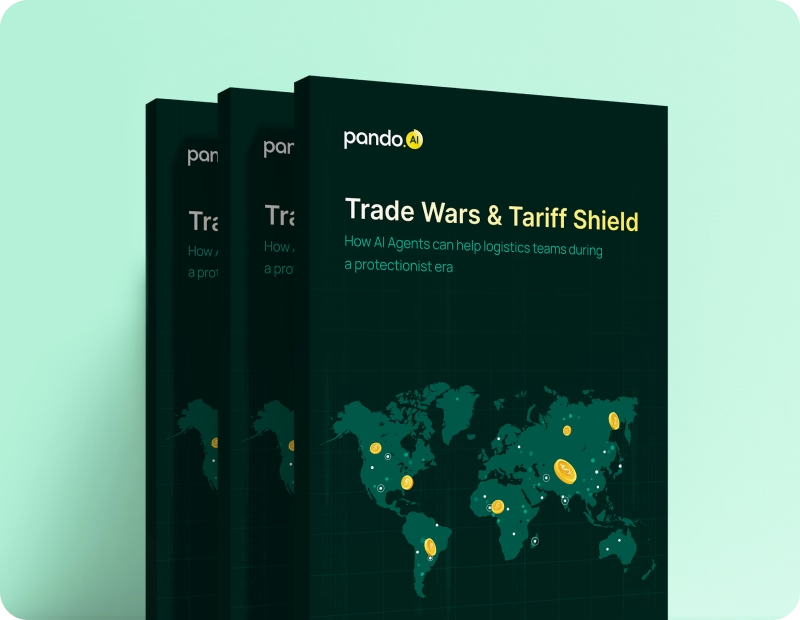-
Products Products
- Industry
- Initiatives
- Resources
- Company
- Book a demo

Before you go: Logistics leaders just dropped the truth on AI
The State of AI in Logistics 2025 is here — no hype, just real conversations and raw insights.
Transportation sourcing 101: Building a resilient and agile logistic network
Master the strategies behind effective transportation sourcing to build a future-ready logistics network.
Published on January 8, 2025 • 8 mins read
Rohit Lakshman

Master the strategies behind effective transportation sourcing to build a future-ready logistics network.
Managing the complex domain of logistics and transportation is a daunting task. You need to juggle countless new challenges to ensure the timely delivery of goods at the right place without crossing your logistics budget. But we often don't realize that transportation accounts for more than 45% to 70% of a company's overall logistics expenses. Strategic transportation sourcing enables businesses to select cost-effective carriers and optimize routes, which significantly reduces overall logistics expenses. With all the buzz around supply chain disruptions lately, considering global pandemics and geopolitical tensions, it is imperative to make smart decisions regarding your transportation sourcing strategies. Being resilient and agile in your logistics and transportation is an absolute must these days if you want to keep up and stand out in the competitive market. A slight difference in delivery timeline and SLA can make or break a deal.
This article will highlight the fundamentals of transport sourcing, along with practical insights and examples of how a sophisticated transportation management system like Pando can transform your logistics operations.
What Is transportation sourcing?
Modern organizations operating with a lean logistics team must prioritize cost-effective shipping methods. Transportation sourcing inadvertently emerges as one of the areas to optimize shipping costs. Transportation sourcing essentially means finding transportation suppliers and carriers, negotiating rates, finalizing and signing contracts, and managing all the paperwork. As it affects transportation costs, delivery timeliness, and customer happiness, a strong transportation sourcing system can set you apart in a market where consumers have extremely high expectations for the speed and reliability of their deliveries.
According to statistics by McKinsey, retailers with robust transportation sourcing are more likely to meet delivery deadlines. These statistics indicate the importance of solid transportation sourcing for organizations.
Strategic transportation sourcing: Key elements for success
When it comes to those hectic shipping times during peak shopping seasons, businesses really need to step up their transportation management system to grab opportunities. For instance, strategic decisions for raw material sourcing guarantee material availability to mitigate the finished product's market demand. After all, a business that meets the fluctuating demand will win the market. In this regard, let's have a look at some key elements of a successful transportation sourcing strategy:
- Carrier selection: Selecting the right carrier for your transportation needs comes under carrier selection. Spread out your carriers so you're not completely exposed at busy times or when things go wrong. Think about the reliability, capacity, and geographic coverage of potential carriers before onboarding a freight carrier.
- Carrier performance monitoring: It is crucial for effective transportation sourcing, ensuring cost-efficiency and operational excellence. Some critical KPIs to monitor carrier performance are on-time delivery, transit times, invoice accuracy, damage rates, capacity utilization, compliance with regulations, and cost per mile. By tracking key metrics like on-time delivery and transit times, companies can choose carriers that meet their service standards. For instance, you can strategically think not to include a carrier in the next contract renewal if it has a higher damage rate.
- Determining the right price: Create agreements that strike a fair balance between affordable rates and high-quality service. During times of fluctuating fuel costs, for instance, a well-negotiated fuel surcharge provision can save you thousands. In such a scenario, an advanced rate manager keeps you ahead of the competition by offering advanced analytics, audit trail notifications, and rate standardization.
- Dynamic contract management: Did you know that by tapping into real-time data, businesses can level up their decision-making in transportation sourcing? They can optimize their logistics sourcing and stay ahead of those market fluctuations like a leader. Dynamic sourcing lets you quickly compare spot rates and contract costs, making procurement management super cost-efficient. This method boosts efficiency and helps in optimizing strategic procurement. For instance, you can make contracts that can adjust to accommodate regulatory changes or changes in demand in the market.
Choosing the right transportation mode: Factors to consider
The success of your logistics operations depends on effective transportation sourcing, including selecting the right carriers, modes, and routes. Evaluating factors like carrier performance and transit times ensures a smooth, cost-efficient logistics network. Think about these things:
- Size of the shipment: When the cargo volume is high and needs a lot of room, the best option is full truckload (FTL). At the same time, less-than-truckload (LTL) shipping is ideal for smaller shipments where you can cut expenses.
- Specialty cargo: The strict restrictions and specialized handling needs of specialty cargo, such as HAZMAT shipments or cold-chain logistics, have a substantial impact on sourcing prices. Operating expenses are driven up by the need for specialized equipment and skilled personnel to ensure compliance with safety regulations and maintain optimum temperature control for perishable commodities. When sourcing transportation, it is crucial to keep these things in mind to guarantee efficiency and safety.
- Speed and distance: For expensive or time-sensitive products, speedy but costly air transport is the way to go. For lengthy distances, rail or sea travel is more cost-effective, although it could take more time.
- Environmental impacts: Transportation mode choices are being more and more impacted by sustainability aims. According to reports, when compared to trucks and airlines, rail and marine transportation generate the lowest emission per kilometer.
Best practices for effective transportation sourcing
The key to successful sourcing is not a one-and-done deal; it's a constant refinement. In this way:
- Use data-guided decisions: Use analytics to identify the best carriers, plan the most efficient routes, and forecast customer demand. One example is the utilization of real-time freight visibility systems, which can reduce delays significantly.
- Leverage multi-modal transportation: Combining modes of transportation allows you to get the most out of your money. According to reports, multimodal transportation promotes efficiency, cuts down transportation costs by 20%, and causes less damage.
- Strong relationship with Carriers: Carefully vetting carriers and fostering long-term partnerships will help you increase your service's quality and reliability. Periodic assessments and collaborative performance reviews can increase service quality significantly.
- Keep a close eye on performance: Keep an eye on metrics like freight cost per unit and delivery accuracy to identify areas where your company might improve. To improve productivity and cut down on mistakes, you can automate these tasks using Pando's platform.
Overcoming key challenges in transportation sourcing
It's quite natural to face problems in the transportation sector. Here are some tips to navigating them with ease:
- Fuel price fluctuation: One way to deal with gas price fluctuations is to switch to more fuel-efficient routes and look into renewable energy sources, like electric vehicles.
- Regulatory compliances: Companies must stay updated with changing regulations, ensuring that carriers comply with local, national, and international laws to avoid delays and penalties. Integrating compliance checks into the sourcing process helps maintain seamless operations and reduces the risk of legal issues.
- Inadequate storage space: During times of strong demand, it is prudent to have both large and small carriers on hand as a precautionary measure.
- Market volatility: To reduce the impact of market volatility, use AI-powered solutions to swiftly modify carrier contracts and routes.
The Role of 3PLs in transportation Sourcing
For companies expanding or entering new markets, outsourcing logistics to third-party logistics providers (3PLs) can be a smart and cost-effective strategy.
Partnering with a 3PL offers significant benefits:
- Expertise and cost savings: 3PLs bring professional knowledge and established industry relationships. For example, they often negotiate better rates with airlines, helping you optimize travel and shipping expenses.
- Simplified operations: With their specialized tools and expertise, 3PLs can efficiently manage complex, multimodal transportation processes, making logistics easier for your internal team.
- Flexible solutions: 3PLs offer scalable solutions to manage fluctuating demand, seamlessly scaling up or down as your business needs change.
While outsourcing to a 3PL provides numerous advantages, it’s essential to carefully evaluate your specific requirements and choose a provider that aligns with your company’s goals.
Sustainability in transportation sourcing: The shift to greener logistics
Do you know that the logistics and transport sector generates more than a third of global carbon dioxide (CO2) emissions? To address this challenge, aligning transportation sourcing processes with sustainability goals is essential.
Here are some strategic steps to make transportation greener:
- Partner with transport companies that utilize low-emission vehicles or alternative fuels.
- Leverage AI-powered technologies to monitor fuel consumption, optimize routes, and reduce mileage.
- Establish clear benchmarks to measure progress toward sustainability targets and track emissions effectively.
By taking these actions, businesses can reduce their environmental impact while staying competitive in an increasingly eco-conscious market.
Key metrics for measuring transportation sourcing performance
To ensure the efficiency and effectiveness of your freight sourcing strategy, it's crucial to monitor key performance indicators (KPIs). By tracking these metrics, you can identify areas for improvement, optimize costs, and enhance overall supply chain performance. Here are some essential indicators to consider:
- Freight cost per Mile: This metric provides insight into the efficiency of your transportation operations. By tracking the cost incurred for each mile traveled, you can identify opportunities to reduce expenses. Factors such as fuel costs, carrier rates, and route optimization can influence this figure.
- On-time delivery rates: On-time delivery is a crucial parameter to track customer satisfaction and supply chain reliability. By monitoring on-time delivery rates, you can evaluate the performance of your carriers and detect any bottlenecks or delays in the transportation process.
- Carrier reliability: Carrier reliability measures the consistency of a carrier's performance. A reliable carrier is one that consistently meets delivery deadlines, minimizes damages, and provides accurate tracking information.
- Service level compliance: Service level compliance assesses your carriers' performance with respect to the specified service standards—that of transit time, delivery frequency, and specific handling requirements. Keeping an eye on this indicator will help you to make sure your carriers are providing the expected degree of quality.
Emerging trends in transportation sourcing
Automated freight sourcing and matching systems are revolutionizing procurement efficiency in the transportation industry. There are many technological and strategic development happening in the industry that will surely change the way transportation sourcing is happening right now.
- Agentic AI: New AI algorithms are changing how transportation is sourced by automatically finding the best routes, predicting bottlenecks, and making it easier to make decisions. Agentic AI doesn't need any explicit inputs and enables real-time adjustments and improves overall efficiency and cost-effectiveness.
- Collaborative shipping: More and more businesses are teaming up to share shipping resources, which cuts costs and damage to the environment. Through collaborative shipping, vehicles' space is shared, which increases load capacities and decreases empty miles.
- Focused mini bids: Companies are switching from infrequent big bidding processes to smaller ones that do happen more often. By working with more carriers in shorter rounds, this method makes it easier to adapt to changes in the market and offers more competitive prices.
By leveraging these innovative systems, businesses can achieve greater efficiency, cut expenses, and elevate their transportation sourcing strategies.
The way forward
An intelligent transportation sourcing system is the foundation of a robust logistics network. So, get ready to revolutionize your logistics! You can improve the efficiency and sustainability of your transportation sourcing process by exploring Pando's innovative solutions and learning how their tools work.
Subscribe to Pando blog and Crossroads newsletter now!
Stay up to date with the latest logistics, transportation, and supply chain tips and news.
Subscribe Here!

Related blogs
The million dollar question: Why logistics experts believe in a future of AI-powered freight procurement?












